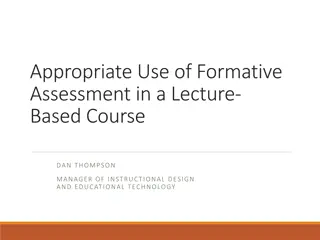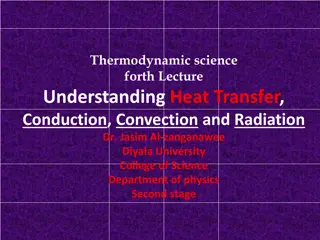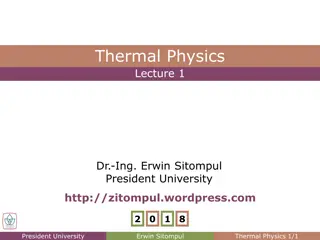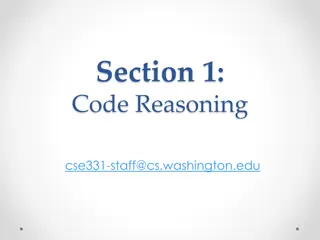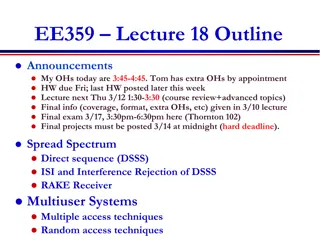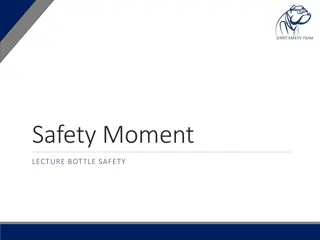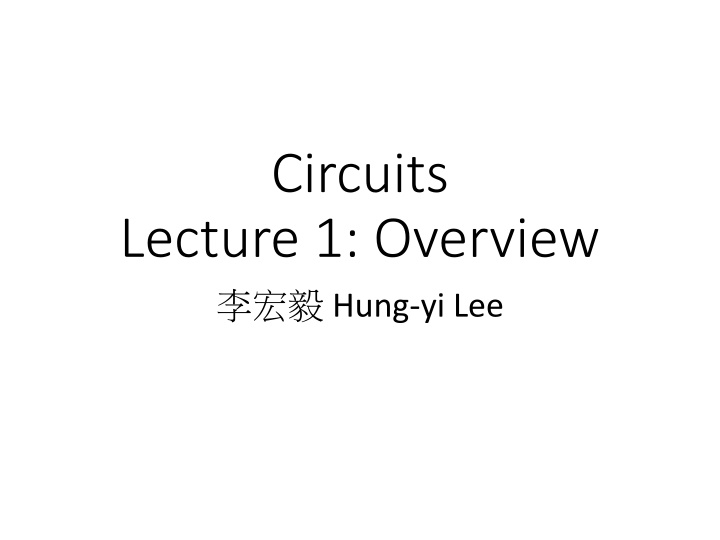
Overview of Circuits Lecture 1 with Hung-yi Lee
Dive into the world of circuits with Hung-yi Lee through this comprehensive lecture series. Explore circuit variables, laws, resistive circuits, dynamic circuits, AC circuits, and more. Get ready for quizzes and the final exam as you learn about different elements in circuits and their properties. Instructor details, course information, exam dates, and study materials are all provided. Join the course to understand voltage, current, power consumption, and the practical applications of circuit analysis in university-level studies.
Download Presentation

Please find below an Image/Link to download the presentation.
The content on the website is provided AS IS for your information and personal use only. It may not be sold, licensed, or shared on other websites without obtaining consent from the author. If you encounter any issues during the download, it is possible that the publisher has removed the file from their server.
You are allowed to download the files provided on this website for personal or commercial use, subject to the condition that they are used lawfully. All files are the property of their respective owners.
The content on the website is provided AS IS for your information and personal use only. It may not be sold, licensed, or shared on other websites without obtaining consent from the author.
E N D
Presentation Transcript
Circuits Lecture 1: Overview Hung-yi Lee
Course Information Time: 09:10 - 10:00 Wednesday and 10:20 - 12:10 Friday Place: EE BL R112 Text Book: A. Bruce Carlson, Circuits: Engineering concepts and analysis of linear electric circuits , 2005 Grade: 3 out of 4 quizzes [60%], Final [40%], No homework
Scope and dates of the Exams (Temporary ) Quiz 1 (10/22) Circuit Variables and Laws (1.4, 1.5) Properties of Resistive Circuits (2.3, 2.4, 2.5) Applications of Resistive Circuits (3.2) Systematic Analysis Methods (4.1, 4.2, 4.3) Quiz 2 (11/12) Dynamic Circuit (5.3) , Transient response (9.1, 9.3, 9.4) Quiz 3 (12/24) AC Circuits (6.1, 6.2, 6.3), AC Power (7.1, 7.2) Quiz 4 (01/07) Frequency Response and Filters (11.1, 11.2, 11.4) Final (01/16) All above Laplace Transform Analysis (13.1, 13.2, 13.3) Two-Port Networks (14.1, 14.2, 14.3)
Instructor Name: Hung-yi Lee Office: EE Building II, R508 E-mail: tlkagkb93901106@gmail.com Personal Webpage: http://140.112.21.28/~tlkagk/homepage/ Lecture recording, slides and announce of exams will both on ceiba and my personal webpage
Outline Overview of Circuits Chapter 1: Circuit Variables and Laws
Outline Overview of Circuits Chapter 1: Circuit Variables and Laws
What are we going to learn? Only one thing Given a circuit, what are the voltage, current and power consumed for an element? Have learned in high school? What is the difference for Circuits in university?
What are we going to learn? 1. Complex Example (the first quiz)
What are we going to learn? 2. Different Kinds of Elements Resistor Voltage Source or battery Controlled Source Current Source Capacitor Operational Amplifier Inductor
What are we going to learn? 3. Dynamic High School This Course
What are we going to learn? 4. New aspects Consider the circuits from the frequency domain Time Domain Frequency Domain Capacitor and inductor behave like resistor in frequency domain
Outline Overview of Circuits Chapter 1.4, 1.5 Review what you have learned in high school
Outline - Chapter 1 3 Variables: Current, Voltage, Power 2 Elements: Resistor, Source 2 Laws: KVL, KCL Examples
Outline - Chapter 1 3 Variables: Current, Voltage, Power 2 Elements: Resistor, Source 2 Laws: KVL, KCL Examples
Variable - Current Current exists whenever charge flows Current: the flow rate of charge ? coulombs of charge pass q = i t in ? seconds ( Unit: Ampere (A) )
Variable - Current = 10 i A 10 A Reference direction Actual Current = 10 i A 10 A Actual Current In this course, current direction is reference direction
Variable - Voltage When a unit charge moves from point A to point B, the energy it lose. Consumed (absorbed) by the elements on the path Absorb ? w = vAB A B q q + ( Unit: Voltage (V) ) Need two points to define voltage
Variable - Voltage Potential: Voltage from one point to a reference point 1 0 V 20 V A A = = vAB 10 V vAB 10 V 10 V B B = = vBC 10 V vBC 10 V 1 - 0 V C C
Variable - Voltage A Actual High potential vAB= 10 v = V A 10 V High potential Actual Low potential Reference direction B Actual Low potential A = vBA= v 10 V 10 V Low potential B B Actual High potential In this course, voltage direction is reference direction
Variable - Power Consumed Power: The rate of losing energy for charge or the rate of consuming by elements w w = p = v t q w q A B - + = = v i p q t q For using the formulation, reference current should flow from + to - (Passive polarity convention) = i t
Variable - Power 4 V - + A B v or i can be negative = p v i 2 A Consumed Power = -8W Consumed Power p can be negative Supplied power = 8W Negative consumed power = supplied power
Outline - Chapter 1 3 Variables: Current, Voltage, Power 2 Elements: Resistor, Source 2 Laws: KVL, KCL Examples
Element - Resistor Ohm s Law: The voltage and current are directly proportional to each other. v i = R When using Ohm s Law, reference current should flow from + to -
Element Sources Current Sources Voltage Sources sv si
Outline - Chapter 1 3 Variables: Current, Voltage, Power 2 Elements: Resistor, Source 2 Laws: KVL, KCL Examples
Kirchhoffs Current Law (KCL) The sum of the current leaving any node equals the sum of the current entering that node. + = i i i 1 2 3
Kirchhoffs Current Law (KCL) generalized bipolar junction transistor (BJT) 10 mA = ? i 10 5 . mA + = + i i i i = 5 . 0 i mA 1 2 3 4
Kirchhoffs Voltage Law (KVL) The sum of the voltage drops around any loop equals the sum of the voltage rises. sv Loop 3 Loop 1 Loop 2 + + + = = + v v v v v v sv v v Loop 1 Loop 2 Loop 3 1 2 + = v v 3 5 2 4 s+ v 1 3 5 4
Outline - Chapter 1 3 Variables: Current, Voltage, Power 2 Elements: Resistor, Source 2 Laws: KVL, KCL Examples
KVL and KCL Example 1.9 Find the current and voltage of all elements. Systematic Solution: Step 1. List all unknown variables and reference directions If there are N unknown variables, we need to list N independent equations. Step 2. Use (a) Element Characteristics, (b) KCL and (c) KVL to list equations for unknown variables
KVL and KCL Example 1.9 + Goal: 7 independent equations 3v + 1v + 3i 1i 2i 2v Step 1. Label unknown variables and reference directions unknown variable: i , 1 , , , , , v i v i v si 1 2 2 3 3 7 unknown variables, so 7 independent equations
KVL and KCL Example 1.9 + Goal: 7 independent equations 3v + 1v A + 3i 1i 2i 2v B Step 1. Label unknown variable and reference direction Step 2 (a) Characteristics of the elements 10i v = v = Step 2 (b) KCL A: is B: i 1 v = i si 7i = 9i + + 24 8 i 3 3 2 2 1 1 3 = + + = i i i i KCL (A) 1 2 3 (dependent to KCL (A) ) 2 3 Actually, n nodes only provide n-1 independent equations
KVL and KCL Example 1.9 + Goal: 7 independent equations 3v + 1v Loop 3 + 2i 2v Loop 1 Loop 2 Step 1. Label unknown variable and reference direction Step 2 (a) Characteristics of the elements v = i v = is = v = 7i = 9i + 10i 24 8 i 3 3 2 2 1 1 3 + i i A: Step 2 (b) KCL KCL (A) 1 2 3 v = = v + v + 25 v 25 v Step 2 (c) KVL KVL (1) KVL (2) (dependent to KVL (1) and (2) ) Loop 1: Loop 2: Loop 3: 1 2 24 v + = 2 3 + 24 1 3
KVL and KCL Example 1.9 + Goal: 7 independent equations 3v + 1v Loop 3 + 2i 2v Loop 1 Loop 2 Step 1. Label unknown variable and reference direction Step 2 (a) Characteristics of the elements v = i v = is = v = 7i = 9i + 10i 24 8 i 3 3 2 2 1 1 A: 3 + i i Step 2 (b) KCL KCL (A) 1 2 3 + v = = v 25 v v Step 2 (c) KVL KVL (1) KVL (2) Loop 1: Loop 2: 1 2 24 + 2 3 For KVL, only consider loop in hole
KVL and KCL Example 1.9 - -45V + Power: R10 : (20V) x (2A) = 40 W consumed 450 W supplied I10: (-45V) x (10A) = -450 W consumed Reference current should flow from + to - V25: (25V) x (2A) = 50 W consumed
Problem set In the following lectures, I will select some problems from textbook as homework ( ) I know you are busy, so I will not select too much problems as homework. Read the examples in the textbook Solve the exercises after the examples Today s homework: Find the small error in Example 1.9 (Fig. 1.33) Be careful about reference direction
Acknowledgement Let me know if you find any errors in my slides. I will put your name at the end of the slides.
Note Reference direction of current Reference direction of voltage Ohm s Law: i = Reference directions of current and voltage should be associated Consumed power: p=vi Reference directions of current and voltage should be associated Negative consumed power = supplied power ? ?





